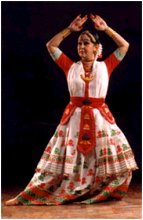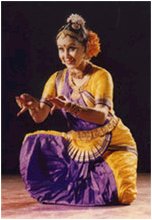
|
 |

|
 |
In Flight February 24, 2004  Sheltering from the heat of a late summer 2003 day at a student café in south London, Indira PP Bora spoke to Richard Turner about a 50 year career that has taken her from Assamese tomboy to Bharatanatyam student of Rukmini Devi and now, international Sattriya guru. "I was brought up in a business family. My parents ran a tea plantation and plywood company in Assam, in a town called Somari. We lived in beautiful surroundings by a small river in an area of tea gardens and rice fields. I used to watch the changing colours of the seasons and enjoy the beautiful nature. My childhood was very wild. I was born when India was still under the British rule, in 1943. I would watch when the British used to come and play Polo, nearby. They looked very grand on their big horses. And they loved to hunt. My father himself was a great hunter. He killed 39 tigers and even some elephants. He taught me to shoot. That was my childhood! "The turning point in my life was when my maternal uncle [Dr Pradip Chaliha] came to visit us. He said "I want to take her with me," offering to teach me Sattriya dance and keep me at my Grandmother's house, where he lived. They agreed and that's where I stayed - for five years! I went to higher school as well, while I was there.  "So, from 1956 to 1961, I learned Sattriya dance. In those days it was still not considered respectable for a girl to dance professionally, but I loved dancing - in any style. I spent many hours dancing, every day. One day, when I was eighteen, my maternal uncle took me back to my parents. He said, "Your daughter is very good. If she goes to a proper [dance] school, she will do well." At first, my parents didn't want to send me, but my uncle persuaded them. 'They took me to Kalakshetra. That was in 1961 and I stayed for thirteen years. Leela Samson was there at the same time and we were very good friends. 'The youngsters now only study for six years before graduation, but in our days it was seven years. It was very strict, when Rukmini Devi was there. "Rukmini Devi could see the beauty of the Sattriya dance. My guru allowed me to perform Sattriya as an item of ten minutes or five minutes in many shows. This was in 1969-72. Rukmini Devi thought it was very beautiful and she encouraged me. "Everything is soft in Sattriya. Like all dancers of eastern India, like Odissi and Manipuri, the body language is very timid. That's the way people move in Assam. In the south their movements are more jerky and sudden. But I love the culture there. I learned to speak Tamil and Telugu while I was at Kalakshetra, but not to read and write them. I started liking Kuchipudi for its music. They are sister dances, Bharatanatyam and Kuchipudi. I simply loved it. 'The Sattriya dance form is dominated by bhakti. It is a living tradition. They still practice it in the monasteries of Assam. I personally feel very broadminded and not at all conservative about adapting it for a foreign audience. You can represent the crucifixion of Jesus Christ in Sattriya, if you want. It can be mixed with other forms and themes. All I want to do is bring a little happiness to the world. "My students learn the pure form, the full A to Z of Sattriya. They must learn the traditional form. After that, they can use any music or text. I give importance to the body language. That's very important. But I am not too conservative. The world will become richer if we share our traditions. After all, the whole world is a family - we are one! When my daughter and I perform we give peace and happiness. "At our college in Guwahati we have got between 300 and 400 students. It was established in 1982. The younger generation are taking more interest now, although there are very few young males. When I was learning it was a man's dance. I was one of only two or three girls. Now it's very popular, with many girls learning both Bharatanatyam and Sattriya. We hold festivals twice a year at our college. The government of India gives the students very good support. Two girls from my college have just been given scholarships to study at Kalakshetra. I'm very proud of them and very happy." By arrangement with veena Indian Arts Review, London. Thanks to Indira's daughter, Menaka PP Bora, for arranging the interview and translating where necessary. |